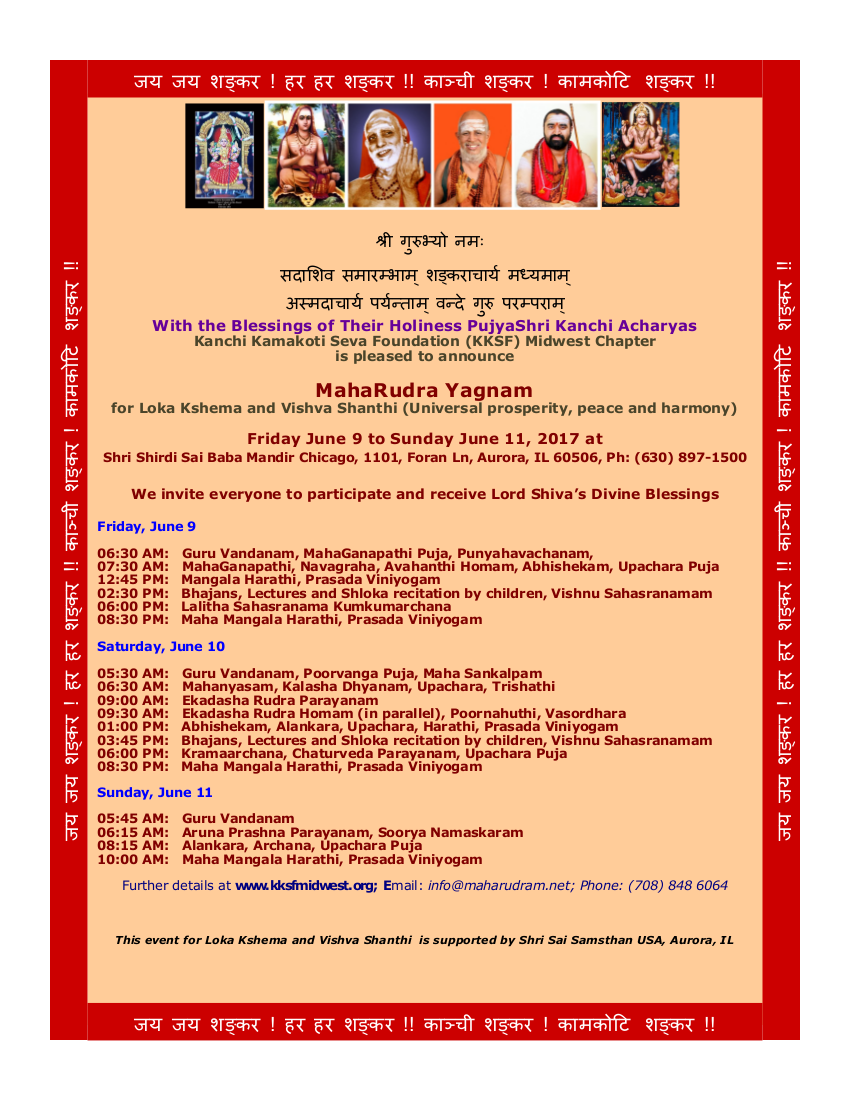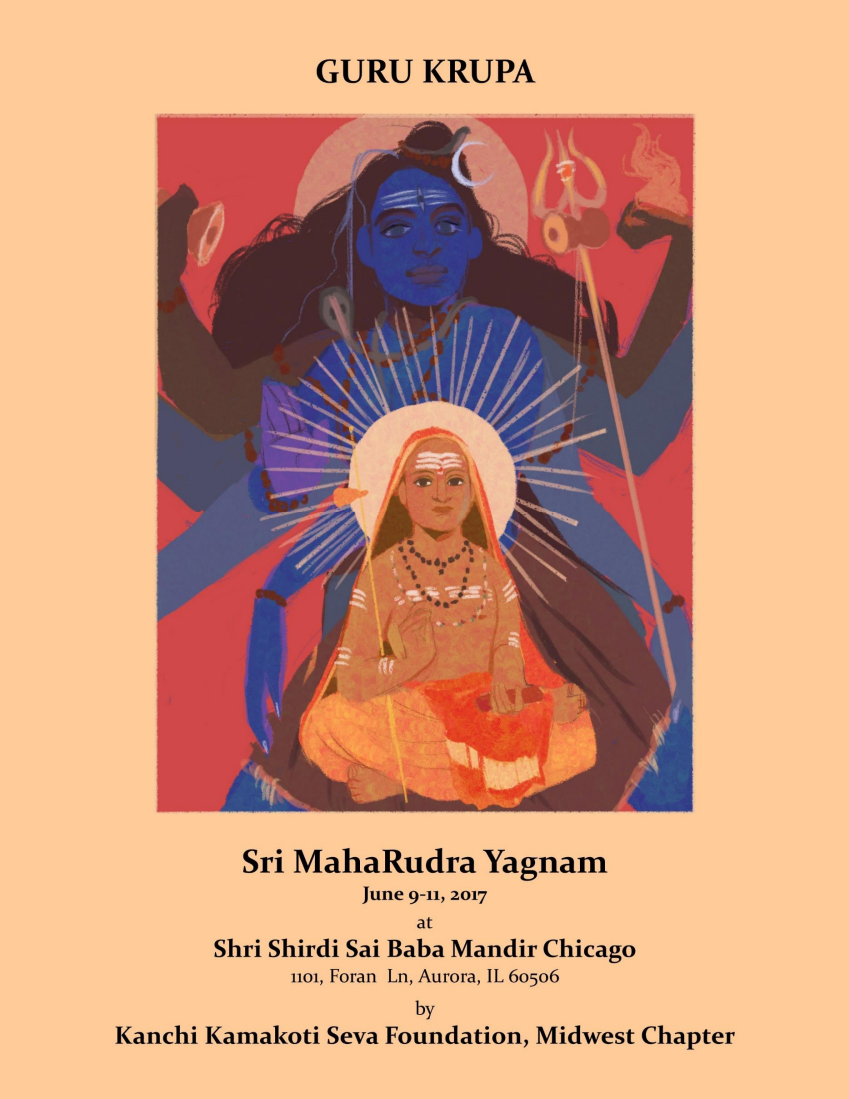जय जय शङ्कर !
The Vedas are equivalent to the Supreme Lord Parameswara and the Supreme God is equivalent to the Vedas.
The Vedas are considered apaurusheyam – not created by humans, having emanated from the breath of
Lord Parameswara. The 11 sections of the Shri Rudram arising from the middle of Krishna Yajur Veda
are considered highly sacred. Even Sanyasis like our Acharyas, chant Shri Rudram. Smruthis say that
when vedic pandits chant the Shri Rudram, Lord Parameswara being an Ashuthoshi, becomes extremely
pleased and in His benevolence, is ready to fulfill the desires and wishes of devotees.
Chanting of the Shri Rudram has been extolled as one of the most efficient means of destroying the
endless and innumerable bundles of papas (sins) that we have undoubtedly accumulated from the beginning
of time and continue to do so in this birth as well – either through acts of commission or omission.
Three important aspects are stressed during Vedic chanting: faith, concentration and knowledge. Perhaps,
the most important of these is to know the meaning and significance of the mantras during the performance
of poojas, chanting the vedas/shlokas, doing yagnams etc. On this topic, His Holiness Mahaswamigal
of Kanchi says – “Veda adhyayana, without knowing the meaning thereof, is like preserving the body
without the soul. Veda mantras uttered with a knowledge of their meaning will lead to papa-parihara
(expiation of sins), arishtashanti (liquidation of evil), and pave the way to brahmasaakshaathkaara
(God realisation)”. Further, the Vedas that are rightfully learned through a Guru, are to be uttered
with correct pronunciation and the right swaras (keynote of sound) – अवक्षरम्अनायष्ुयम्ववस्वरम्व्याविपीवितम्(avakṣaram
anāyuṣyam visvaram vyādhipīḍitam). Not adhering to these rules causes one to have a shorter lifespan
(anāyuṣyam) or suffer ill health (vyādhipīḍitam).
Significance of MahaRudram
Prathamo deivyo bhishak from Shri Rudram indicates that He is the first healer/doctor for all ailments
and sins. Vibrations obtained by group chanting of Shri Rudram and Chamakam work miracles to cure
mental and physical distress and to cast away all sins from our previous births. The Kaivalya Upanishad
recommends thus: he who studies the Shatarudriya is purified by the fires, from the sins of drinking,
killing a Brahmana, deeds done knowingly or unawares. Through this he has his refuge in Shiva, the
Supreme Self. The Rudram has enshrined in it the famous panchakshari mantra – Om Namah Shivaya –
which has tremendous potency as a nullifier of accumulated papa-karma. Shri Gurubhyo Namah: Jaya
Jaya Shankara Hara Hara Shankara!
Lord Parameswara manifests in two forms: Rudra, the Ghora
or fearful form, and Shiva, the auspicious form. Rudra is considered as a deity who teaches the supreme
knowledge to all and whose energy flows in everything. Shiva is His benevolent manifestation and
signifies everything that is good. By repeated chanting of Sri Rudram, we invoke His blessings, for
He will usher in goodness, ward off all evil, and ring in peace and harmony. However, He has an angry
and destructive side to Him – that of Rudra. Sometimes it becomes necessary to destroy to renew.
Rudra destroys so that there may be a renewal. If we see sin all around us we call upon Rudra to
destroy and rid mankind of it, so that there is a new beginning. Shiva is the holder and nurturer
of the universe till the time of the next cycle of creation, which is necessarily preceded by destruction
brought about by Rudra. Thus, Shiva and Rudra, underscore the basic philosophy of Hinduism – duality.
For e.g., good follows evil; after darkness is light; and life leads to death which in turn leads
to life.
The purpose of chanting this magnificent hymn is just not to worship in religious
fervor but to instill in the minds of the people that He is immanent in every particle, in every
speck of space, in every unit of time, in every particle of creation (AnOraneeyan, from the Taittiriya
Upanishad) and at the same time, He is larger than the largest (MahathOmaheeyan, from Taittiriya
Upanishad). An intriguing aspect of this wondrous hymn is that God exists in both the aspects: the
good and the bad, the beautiful and the ugly, the right and the wrong, the positive and the negative,
the high and the low, the conceivable and the inconceivable, mortality and immortality, existence
and non-existence.
हर हर शङ्कर
Tamizh scriptures also talk about Rudra during pralaya kaala performing His oozhikoothu (the Rudra Thandavam).
Shivanadiyaar Appar in his Tamizh padigam:
பெருங்கடல் மூடி ப்ரளயங்பகொண்டு பிரமணும்பெொய்
இருங்கடல்மூடி இறக்கும்; இறந்தொன் கபளெரமும் கருங்கடல் வண்ணண் கபளெரமுங்பகொண்டு கங்கொளரொய் வருங்கடல்
மீள நின்று எம்மிறற நல்வீறண வொசிக்கும
Perungkadal moodi praLayamum kondu piramanum pOi irunGkadal
moodi irakkum; irandhAn kalEbaramum karunGkadal vaNnan kalEbaramum kondu gangAlarAi varunGkadal mILa
ninru emmirai nalveenai vAsikkumE
narrates, that when pralaya happens, everything in this
universe, including Brahma, is taken in by Rudra. At that time, what remains indestructible are the
One with the third eye, namely, Rudra Himself (‘கங்கொளரொய்’ – gangAlarAi), and the One who emanated
from the divine sparks from His third eye, Lord Karthikeya.
By chanting or listening to
the Rudra Prashnam, we pray to, prostrate before, and identify Rudra with everything in the Namakam.
Chamakam is usually recited immediately after, in which the devotee asks Lord Shiva to give him everything,
347 things to be precise, coupled with the article ca (which means ‘and’ in Sanskrit) and the verb
me kalpatam (be granted unto me). Chamaka Prashnam furnishes completely the idea of human happiness
and defines in the highest degree the desires to be asked or to be granted – from material needs
all the way to divine fulfillment.
MahaRudra Yajna is one of the highest forms of community
worship, performed with the involvement of 121 ritwiks chanting the Shri Rudram 11 times, totaling
1,331 times followed by one tenth, dhasAmsam (133) recitations along with offerings (ahuti) to Parameswara
in the yajna (homam).
Performing the MahaRudram as per the Sastras, blesses mankind and
all living organisms with desirable weather conditions, protection from natural calamities, bountiful
produce, peace, and prosperity.
Om Shanti, Shanti, Shantihi.

